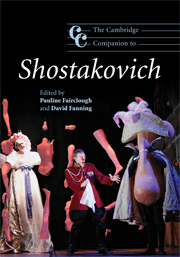Book contents
- Frontmatter
- Introduction
- PART I Instrumental works
- PART II Music for stage and screen
- PART III Vocal and choral works
- PART IV Performance, theory, reception
- 12 A political football: Shostakovich reception in Germany
- 13 The rough guide to Shostakovich's harmonic language
- 14 Shostakovich on record
- 15 Jewish existential irony as musical ethos in the music of Shostakovich
- Notes
- Select bibliography
- Index
13 - The rough guide to Shostakovich's harmonic language
from PART IV - Performance, theory, reception
Published online by Cambridge University Press: 28 September 2011
- Frontmatter
- Introduction
- PART I Instrumental works
- PART II Music for stage and screen
- PART III Vocal and choral works
- PART IV Performance, theory, reception
- 12 A political football: Shostakovich reception in Germany
- 13 The rough guide to Shostakovich's harmonic language
- 14 Shostakovich on record
- 15 Jewish existential irony as musical ethos in the music of Shostakovich
- Notes
- Select bibliography
- Index
Summary
Points of origin
However diverse the influences on Shostakovich's idiosyncratic harmonic language, and however ambivalent his attitude to the tradition in which he was schooled, he was ineluctably a descendent of the Rimsky-Korsakov school. There is good reason therefore to launch this survey with a paradigmatic example from the master pedagogue, its symbolism forming as much a part of Shostakovich's inheritance as the technical aspect.
The first evidence for the existence of the Devil in Rimsky-Korsakov's Gogol opera Christmas Eve is to be found in bar 6 of the Prelude to Act 1. Here the preceding pattern of major triads descending by thirds (E–C sharp – A–F sharp – D–B–G) would suggest one last fall to E to close the circle of this D major diatonic collection of chord roots. Instead the G falls only to F, which forms a tritone with the still sounding B of the G triad (see Ex. 13.1).
Over the course of the next four acts, numerous tritones will follow as the Devil purloins the moon and stars, cavorts with the witch Solokha, and attempts to catch and then escape from his nemesis, the icon painter Vakula, who has confined him to a burlap sack and ordered that the Devil fly him from Dikanka to St Petersburg and back. In both nocturnal voyages (Act 3, 6th tableau; Act 4, 8th tableau) Rimsky-Korsakov expands the tritone count from one to four. From this he creates passages that evoke the disruptive, nihilistic influence of dark powers by means of rootless diminished- seventh chords and linear segments, in which the four tritones interlock to create the eight-note ‘octatonic’ scale (see Ex. 13.2, where all pitches belong to the scale of semitone–tone alternations upwards from E).
- Type
- Chapter
- Information
- The Cambridge Companion to Shostakovich , pp. 298 - 324Publisher: Cambridge University PressPrint publication year: 2008
- 2
- Cited by

